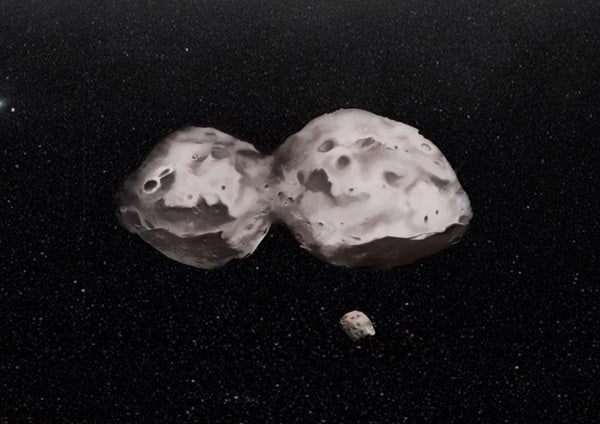This study, based on W. M. Keck Observatory data and photometric observations from telescopes throughout the world, suggests that the asteroid and its moon are products of the collision of two icy asteroids. This work sheds light on the complex youth of our solar system, when the building blocks that formed the core of giant planets and their satellites were tossed around or captured during the giant planet migrations.
In 2006, a small team of astronomers led by Franck Marchis from the Carl Sagan Center of the SETI Institute in Mountain View, California, detected the presence of a small 7.5-mile-diameter (12 kilometers) moon around the large Trojan asteroid (624) Hektor. They used the 10-meter Keck II Telescope atop Mauna Kea, fitted with the Near-Infrared Camera 2 (NIRC-2) instrument behind the adaptive optics and laser guide star system (LGS-AO).
Since then, they collaborated with several researchers from the University of California, Berkeley, to determine the orbit of this moon and understand the origin of the system. Trojan asteroids are those that are temporarily trapped in regions 60° in front of or 60° behind the planet Jupiter in its orbit around the Sun. They are difficult to study because they are small and faint.
While the asteroid has been studied for eight years, there were a couple of significant challenges. “The major one was technical: The satellite can be seen only with a telescope like Keck Observatory’s fitted with LGS-AO, but time on the mighty Keck’s is highly prized and in limited availability,” said Marchis. “Secondly, the orbit of the satellite is so bizarre that we had to develop a complex new algorithm to be able to pin it down and understand its stability over time.”
The research, conducted with expert assistance from colleagues at the Institut de Mécanique Céleste et de Calcul des Éphémérides (IMCCE) of Paris Observatory, revealed that the 7.5-mile (12km) moon orbits the large 155-mile (250km) asteroid every three days at a distance of 375 miles (600km) in an ellipse inclined almost 45° with respect to the asteroid’s equator.
“The orbit of the moon is elliptical and tilted relative to the spin of Hektor, which is very different from other asteroids with satellites seen in the main belt,” said Matija Cuk from the Carl Sagan Center of the SETI Institute. “However, we did computer simulations, which include Hektor being a spinning football shape asteroid and orbiting the Sun, and we found that the moon’s orbit is stable over billions of years.”
Hektor has been known since the 1970s to be spinning rapidly (less than seven hours) and extremely elongated. Using the high angular resolution of the Keck II Telescope, combined with a large number of photometric observations taken since 1957, the team built a refined shape hoping to get a clue to the origin of the system.
“We built several models of equal quality from the photometric data, but we favored a model made of two lobes since some of the best adaptive optics observations suggest that the Trojan asteroid has a dual structure,” said Josef Durech from Charles University in Prague.
A complex shape for the asteroid and a bizarre orbit for the moon will be matters of discussion for the scientific community. The team speculated that the moon could be ejecta produced by a slow encounter that formed the bilobed asteroid but emphasized the need for robust and accurate simulations.
“We also show that Hektor could be made of a mixture of rock and ices, similar to the composition of Kuiper Belt objects Triton and Pluto. How Hektor became a Trojan asteroid, located at only five times the Earth-Sun distance, is probably related to the large-scale reshuffling that occurred when the giant planets were still migrating,” said Julie Castillo-Rogez from the Jet Propulsion Laboratory in Pasadena, California.
Hektor was discovered in 1907 by August Kopff. The satellite of Hektor, discovered in 2006 by Marchis and his team, has not been named yet. The team welcomes any idea for naming the satellite, keeping in mind that the satellite should receive a name closely related to the name of the primary and reflecting the relative sizes between these objects.










